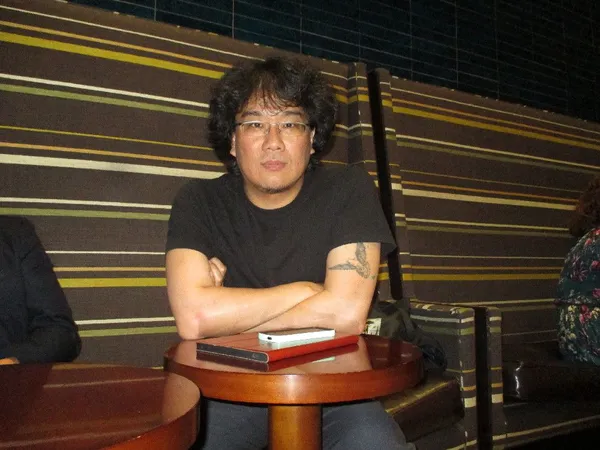 |
| Bong Joon-ho director of Snowpiercer on John Hurt as Gilliam: "A Korean Buddhist scholar compared that character to Buddha." Photo: Anne-Katrin Titze |
When I spoke with Bong Joon-ho the week of his US release for Snowpiercer, we discussed not being able to escape from Fritz Lang's Metropolis, not even Ridley Scott with Blade Runner. I was treated to the visual inspiration behind Tilda Swinton's look in Snowpiercer and a personal story of political protest in Korea in the Eighties that found its way into the aquarium sushi bar scene. We talked about climate weapons, dreams of an eternal engine, re-casting Ah-Sung Ko and Kang-ho Song from The Host and why John Hurt's character relates to Buddha. The catastrophe that turned the world to ice in Snowpiercer's background story, takes place on a date less than a week away.
Anne-Katrin Titze: July 1, 2014 is coming up fast. Are you at all superstitious?
Bong Joon-ho: In Korea, as in most Asian countries there's a lot of superstition. Yeah, it's interesting a week after opening the film it will be July 1.
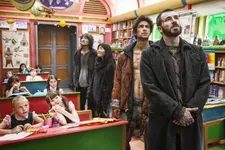 |
| Snowpiercer school on board: "It's not that I think of myths or fairy tales in advance and decide to use certain aspects consciously." |
AKT: Is that the date in the graphic novel [the French graphic novel Le Transperceneige by Jacques Lob, Benjamin Legrand and Jean-Marc Rochette] or did you make that up?
BJh: Actually CW7 [the chemical intended to reverse global warming that accidentally brings about a new ice age] doesn't appear in the original graphic novel at all. In that story it's a third World War and the two sides were using climate weapons. It's only mentioned briefly in a piece of dialogue in the comic book. The opening is totally new as is the entire story. We just took the basic concept and worked out everything else.
AKT: Were you at all inspired by Metropolis?
BJh: Fritz Lang? Perhaps for every Sci-fi director we all live inside the boundaries that Lang created in Metropolis. For example Blade Runner. I didn't actually re-watch Metropolis when I was preparing Snowpiercer. But thinking about your question now I realise that it's also about a closed society and a controlled society similar to this film. Have you seen this photo before?
He pulls up the image from Fritz Lang's 1927 Metropolis set.
AKT: No. Wow, this looks great.
BJh: They are making the sets. It's a very strange photograph. An iconic set piece from the movie.
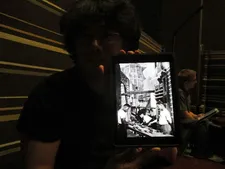 |
| Bong Joon-ho's Metropolis vision: "Perhaps for every Sci-fi director we all live inside the boundaries that Lang created" Photo: Anne-Katrin Titze |
AKT: You also mention Blade Runner. It's true, you'd have a difficult time making a science-fiction film devoid of these references. Still I found something very new in your film. Because it's a train.
BJh: Because it's a train. There are so many post-apocalyptic stories and movies. [In Snowpiercer] the last remaining survivors on earth are all inside this train. The train is physically divided into cars, but then those cars are divided into class. With the rich in the front and the poor in the back. This basic concept was such a brilliant one created and invented by the original graphic novel writer Jacques Lob.
By virtue of that, being set inside a train, we were able to be different from other sci-fi films.
AKT: And it's such an old-fashioned thing - the train itself. It makes for a nice time loop. The future within the past, in a way, going round and round the world through the eternal ice. Of course, you reference global warming and the fact that we do things we don't know the consequences of. You've shown a similar premise in The Host. Is this an idea at the core of your cinema?
BJh: If you contextualise it this way, then, yes, Snowpiercer and The Host are similar in that regard. The script of Snowpiercer is really about the idea that humans, in the system that humans create, they try to control everything. Whether it be society or nature. But it's really showing that it's not possible. The idea is that people want to control nature or stop global warming but the CW7 actually has a reverse effect and creates a new ice age.
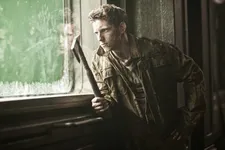 |
| Jamie Bell as Edgar an axe man: "After the bloodiest fight in the film up to that point with the axe-battle" |
Also inside the train they talk about the eternal engine but it's actually starting to fail. It's actually lies - that's a bit of a spoiler - but it takes little children to keep the engine maintained and it's actually on its way to failing completely and becoming extinct. That's a word that's used repeatedly throughout the film. It's a key idea that the engine is not forever. Actually it's about the return of nature. Nature is what is eternal and not the people that are trying to control this system that's manmade.
AKT: Another connection I made between The Host and this film is the tale of Hansel and Gretel. Children, seen holding hands, not necessarily brother and sister, are facing the witch, or whatever life threatening adventure, they are forced to embark on. A sea-monster from a Seoul river…
BJh: They are actually sister and brother inside the creature there!
AKT: What is the relationship you have to folktales and to this one in particular?
BJh: It's not that I think of myths or fairy tales in advance and decide to use certain aspects consciously. After I write the script, I think back and realise that there are certain ideas and certain connections. For example, Yona, in the film, she's actually the same actress that appears in The Host (Ah-Sung Ko). She is in reference to the biblical story. The spelling is different but it's Yona who is inside the belly of the whale.
In The Host, the father pulls her out, literally, from the stomach of the beast, the monster. In Snowpiercer, it's played by the same actor [Kang-ho Song as Namgoong Minsu]. He pulls her out of the drawer in the prison section. Whether it's a legend or fairy tale or a tale from the past, it's always inspiring us.
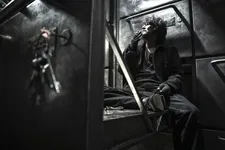 |
| Kang-ho Song as Namgoong Minsoo: "He pulls her out of the drawer in the prison section." |
AKT: Twice the father is giving birth to his daughter.
BJh: Even though I didn't realise it at the time, a lot of people have different interpretations. For example, Gilliam, the character John Hurt plays, he sacrifices his arm, which comes out of the story about what happened 17 years before in the tail section. A Korean Buddhist scholar compared that character to Buddha. There's a lot of references that are present everywhere.
AKT: I'd like to switch from stories to visuals. You managed to make Tilda Swinton look the ugliest I have ever seen her on screen.
BJh: Ugly but cute!
AKT: Ugly but cute? I don't think so. How did you come up with the costume and make up for her?
BJh: Tilda actually wanted to take the look further and I had to pull her back. She at the time really wanted to transform herself and look different than she ever looked before. I was all for it. Obviously there was something that started the whole look. By accident, I saw this image of a woman inside a British museum and I showed the photo to Tilda and she loved it. That was the start of the character.
He pulls up the image that inspired Tilda Swinton's look and shows it to me.
AKT: Great image. These are dead birds she is sorting?
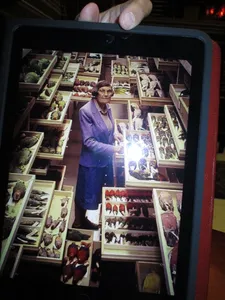 |
| Role model for Tilda Swinton's Mason in Snowpiercer: "I saw this image of a woman inside a British museum" |
BJh: Yes, it's like a bird museum. We called her Bird Lady.
AKT: Even the shoes. I can see why Tilda wanted to become her.
BJh: If she's still alive, I wonder what she'd think. Her hairstyle and glasses.
AKT: You have these moments in Snowpiercer when the spectator is engrossed in the actions and then you throw the audience completely out of the story with pieces of dialogue. "Any one feel like sushi?", for example, or the moment when they talk about Marlboro Lights being extinct for ten years. Is this a rhythm you are going for? You get us involved and then pull us out?
BJh: It might seem random but I really like those moments. The sushi bar is a perfect example where I was going for that feeling you described 200%. After the bloodiest fight in the film up to that point with the axe-battle, suddenly they're inside this man-made aquarium inside of a sushi bar, eating sushi after eating [disgusting looking black-metal-jello] protein blocks for seventeen years, looking out at the frozen ocean in a daze. That sort of irony I really wanted to achieve.
AKT: It has a strong effect. The discrepancy in emotion is so huge.
BJh: Actually this is based on a real event. In the Eighties, when I was in college in 1988. That was almost the end of the military dictatorship. I was a student protester. I was part of a lot of demonstrations against the government and I would have to run away from riot police. In one particular instance, I ran away and opened a random door and ended up in a very classy, high-end hotel.
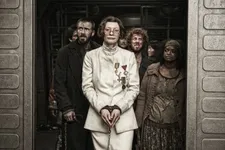 |
| Tilda Swinton as Mason: "Tilda actually wanted to take the look further and I had to pull her back." |
I found myself in this lobby where there was piano music and just two seconds ago they were shooting tear gas at me. There I was listening to Mozart and guests were dressed up in nice clothes drinking coffee as if nothing was going on. I was just in a daze, thinking 'where am I'? That feeling is definitely a part of the sushi bar scene.
AKT: What's coming up for you?
BJh: I'm working on two scripts. They're going to be smaller than Snowpiercer. Korean language. I can't really say what the genre is, yet. I always only know after I'm done writing.
In the first of my conversations on Snowpiercer, I spoke with John Hurt on his pivotal role in Bong Joon-ho's not so merry-go-round science fiction thriller.
Snowpiercer opens today, June 27 in the US.
Snowpiercer's remaining screenings at the Edinburgh International Film Festival are on June 28 and June 29.





















